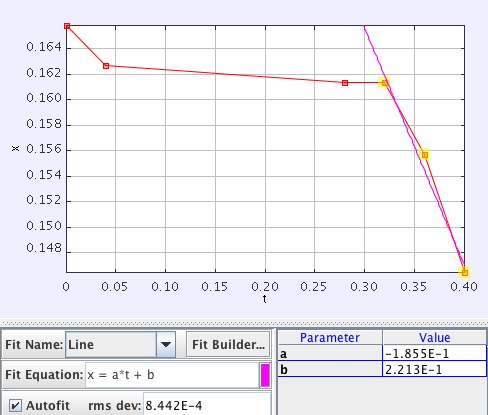Hat tip to Frank for sending me a link to this video:
If you have never done a demo like this (without the motorcycle), you should. It really isn't too difficult. Here is a video of my version:
Inertial demo from Rhett Allain on Vimeo.
So, the question is: is the motorcycle thing real or fake?
First, let me talk about the key aspect of this demo. Why don't the glasses move? Well, they move - but just not very far. The demo is supposed to be an example of Newton's Second law, or you could say it is the momentum principle (which is what I will use). If a force is applied for a short time interval, the momentum will not change too much. Here is the momentum principle:

And here is a diagram of a glass on a table with the cloth being pulled out.

Ok, so I know the demo works - I have done it. However, let me look at some of the parameters involved.
Static vs. kinetic friction
If the glass is moving with the same speed as the tablecloth, then there would be static friction between the two objects. This is bad because 1) the glass would be moving and 2) the static friction can have a greater value than the kinetic friction. The key is to make the table cloth have a high enough acceleration so that the static friction force is not enough to keep the glass at the same speed as the cloth. So, the magnitude of the max static friction force is:
Where N is the force the tablecloth pushes up on the glass (the normal force). Since the glass is not accelerating in the vertical direction:

Where m is the mass of the glass. So, the maximum horizontal acceleration for static friction would be:

And, this is why I put some slack in the cloth before pulling it out. I can get a huge acceleration that way.
Time interval
So, suppose it is sliding. No need to worry about the static friction force. The force diagram would essentially look the same except that the friction force would be a bit smaller. The next key thing is the time interval. You want this friction force to be on the glass for as short of a time as possible. The momentum principle says:

I guess I could put in the model for friction. In this case, I could get the scalar equation (for the horizontal direction)
Now for some measurements
This video has something very useful. First, the demo is done as a normal demo. If I assume this first part is real (and why wouldn't it be - since I can do this myself?), then I can assume that the parameters are the same for both cases. Using my uber-tracker video skills (Tracker Video), I can get the time for the cloth to leave and maybe an estimate for the motion of the glass.

I know this is really a rough measurement, but from that video - the cloth is moving under the glass for about 0.12 seconds. If I had a good measurement of the final velocity of the glass, I could get an estimate for the coefficient of friction. This is my best shot:

So, if I assume a change in velocity 0.19 m/s and a delta t of 0.12 seconds, then:

Measuring the BMW version
Whoever made this video hasn't paid attention to what I have said about video analysis. The camera is not on a tripod AND they zoom out. Well, let me first get the time. Going through frame by frame, it looks like it took about 0.6 seconds. I will give it a value of 0.5 seconds just to be safe.
So IF I assume that the coefficient of friction is the same, then how fast would the glasses be moving after the tablecloth is pulled out?
That gives a speed that is about 4 times faster than the other dishes. Those dishes do move, but it seems like they should move more than that.
Is it fake
So, here are the options:
- It is fake. Don't know how they did it, but they did something. Whatever they did, it looks convincing enough. The dishes do move some.
- It is not fake and the model I was using for friction does not apply in this case because the tablecloth is moving so fast (remember, friction is actually pretty complicated).
- It is not fake and I just made an error somewhere - perhaps with my measurements.
Update
It seems like The Blog of Phyz posted this before I finished my analysis.

 Rhett Allain is an Associate Professor of Physics at Southeastern Louisiana University. He
enjoys teaching and talking about physics. Sometimes he takes things apart and can't
put them back together.
Rhett Allain is an Associate Professor of Physics at Southeastern Louisiana University. He
enjoys teaching and talking about physics. Sometimes he takes things apart and can't
put them back together.


Comments
I'm going for it's fake due to the duration that cloth is on the table.
Unless people know if something like teflon (in quantities normally used for lubrication) can me made into a cloth like material.
Posted by: Who Cares | March 8, 2010 4:24 PM
Commercial polypropylene tablecloth impregnated with anti-stain is about as slick as teflon. Maybe dampen it down a bit too for added lubrication and I can see it happen.
Posted by: Mu | March 8, 2010 4:53 PM
Fake -- all of the stuff on the table seems equally affected by the tablecloth (i.e. not much), but the impulse acting on the objects at the far end is much, much less than the impulse on the objects at the motorcycle end, due to the difference in contact time with the cloth.
Posted by: Len Bonacci | March 8, 2010 4:58 PM
I'm going with real. In stop-action, I can see the earlier candlesticks move more than the later ones, consistent with the acceleration of the bike. I suspect that one major difference in the first and second versions of the trick is the acceleration; the first trick reached a top speed and had no where to go from there, while the second one may have avoided some of the static/accelerating friction probs. I suspect (but am no physicist) that a constant rate of pull would have been problematic by the end.
Posted by: Anon | March 8, 2010 5:39 PM
It seems to me like the dishes are all sort of vibrating in place - I guess that could happen? But it looks kind of odd.
Plus the hyper-enthusiastic guys coming in to congratulate the biker are kind of overdoing it; reminds me of the faked giant-waterslide video.
Posted by: josh g. | March 8, 2010 5:51 PM
@ who cares, fwiw, Cordura is teflon. stretched very quickly.
Posted by: peter | March 8, 2010 7:19 PM
@ Anon (#4): If by "earlier candlesticks" you mean the ones at the end farthest from the motorcycle, they should move less, regardless of the acceleration of the bike. The acceleration doesn't matter.
We're assuming a kinetic friction case here, and that F(k) is constant (probably not, but oh well). The objects, while on the tablecloth, experience a change in momentum of F(k) times time -- the longer they are on the table cloth, the greater the momentum gain. For two objects of equal mass (e.g. the wine glasses), this means a greater velocity gain.
So now you've got two wine glasses at opposite ends of the table. The one at the far end is not moving very fast, because the table cloth was away almost immediately. The one at the motorcycle end has had the table cloth acting on it for about 0.7 seconds, by my reckoning (about 18 frames at 25 fps). It has a greater velocity.
Once the table cloth is no longer under an object, the object's forward motion is halted by kinetic friction with the table. We'll assume this is a constant force as well. Constant force means constant acceleration (slowing down in this case), and under these conditions an object will travel a distance of (speed squared)x(mass)/(2F). So the distance travelled gets larger as the square of the speed.
Bottom line, you should see a much larger separation of objects at the motorcycle end of the table than at the far end. This is not evident in the video.
Or, you can play with the trick yourself (just the small table version) -- you will easily convince yourself that anything that is under the moving table cloth for as much as 0.7 seconds is not going to stay in the same place!
Posted by: Len Bonacci | March 8, 2010 8:49 PM
Sorry, one last thing. Not only is it fake, but I'm going to suggest that the entire sequence of the tablecloth being pulled by the motorcycle is CGI -- in several early frames, they didn't quite get it right and it looks like the bystander is in the middle of the table cloth. Hard to describe without a screen shot, but the far edge of the cloth is behind the bystander, with his body breaking the line.
Posted by: Len Bonacci | March 8, 2010 8:55 PM
fake-ish. #3 is right, everything seems similarly affected. I think there was a layer of glass or something clear on top of the tablecloth but under the dishes.
Posted by: Dave X | March 8, 2010 10:04 PM
Why are people saying the stuff on the table moves? It doesn't move along the table at all, just kind of vibrates in place, like Josh above said.
Just keep your eye on the first candlestick, noting how it lines up with the window frame behind it, you'll see that nothing moves along the table at all.
Ask yourself, what would be easier, faking it with the usual FX magic, or actually getting a motorcycle to accelerate more or less instantly to the speed required, especially on a smooth concrete floor?
Bit of a no-brainer really...
Posted by: Alan | March 10, 2010 3:51 PM
Have you guys heard of camera tricks? A shot of vibrating dishes is superimposed on the tablecloth-pulling shot.
Posted by: Ick | March 10, 2010 4:02 PM
The waste of resources on this debate is very high, while the veracity can be determined by summing up the weight (down force) of the objects above.
Posted by: Kids Encyclopedia | March 10, 2010 4:47 PM
This video is fake, towards the end of the tablecloth coming off the cloth flips up under the stuff on the table showing the material on top was super-imposed over the cloth. You may suspect that this is from the edge flicking up, however sides would flick out, not up, the top would however flick up. Basically they have used a reasonably heavy cloth on an empty table then placed an image of wobbly tableware on the top.
The cloth coming off also shows a table with a white surface as the cloth comes off, however the shot showing the table later shows a wood surface.
The makers of this shot should have made sure to have a white table rather than a brown one, a well as hiding weights in the corners of the tablecloth, then they would have not made these errors.
Posted by: Joel | March 10, 2010 7:45 PM